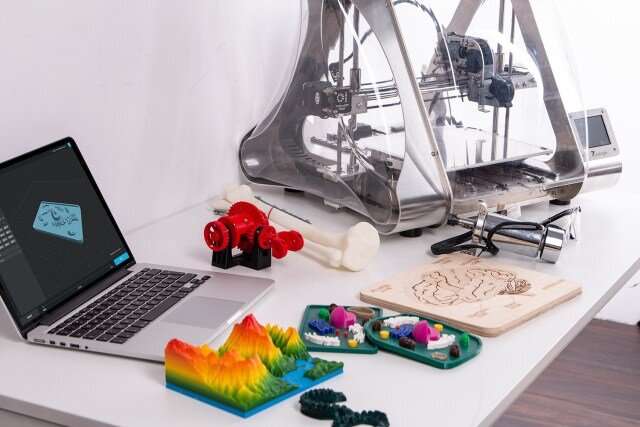New process could strengthen 3-D-printed materials by 200 percent

The strength of 3-D-printed products could be improved through a new technique developed by scientists at UT and Oak Ridge National Laboratory.
The new process, which uses UV irradiation, could strengthen bonds of 3-D-printed materials to withstand 200 percent more transverse stress, according to a study published in Macromolecules.
Fused deposition modeling (FDM) is a popular technique in the manufacturing industry and is used regularly in printing prototypes, molds of industrial processes, and tailored parts across many industrial fields. In FDM, a filament is passed through a heated nozzle and deposited layer by layer to create a structure.
"There are about a half dozen methods of 3-D printing, and a lack of layer adhesion is a problem in all of them. This means that many of these materials are brittle, so they can't handle much strain before they break," said coauthor Mark Dadmun, professor of chemistry at UT and an ORNL–UT joint faculty member.
Dadmun and his team became interested in this problem when a 3-D-printed car was produced at ORNL. "While this was an amazing accomplishment, those cars are not actually drivable because they have weaknesses. If there were ever a crash, these cars would splinter."
These weaknesses are the result of poor layer adhesion due to the bulky nature and minimized interactions of polymer chains between layers. But Dadmun had an idea to solve this problem.
"We found that making chemical bonds across the layers of printed product would strengthen the item, because the molecules are now bonded together rather than being in layers where the molecules are just floating by each other," said Dadmun.
In the new process, chemical bonds are formed when a UV light is applied during printing. The UV starts a reaction that bonds the printing material, overcoming the problem and creating stronger materials. The method is easily implemented and offers improvements in FDM for multiple materials.
Dadmun and his colleagues are now working on expanding this method to other materials.
"Ultimately, we want to take 3-D printing from a maker technology to a manufacturing technology," said Dadmun.
More information: Neiko P. Levenhagen et al. Reactive Processing in Extrusion-Based 3D Printing to Improve Isotropy and Mechanical Properties, Macromolecules (2019). DOI: 10.1021/acs.macromol.9b01178
Provided by University of Tennessee at Knoxville





















